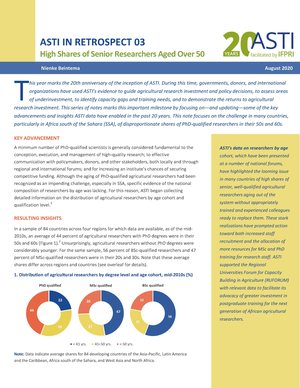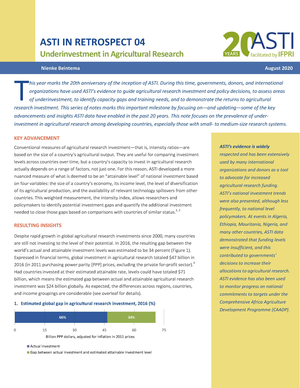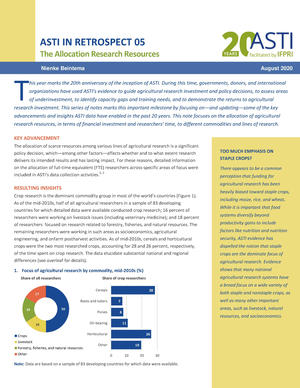ASTI IN RETROSPECT 01 The Role of Women in Agricultural Research
ASTI’s gender-disaggregated data have provided important insights into the demographics of women’s participation in agricultural research.
- By the mid-2010s, women constituted one-third of the total number of agricultural researchers employed in low- and middle-income countries.
- Although considerable progress has been made over time, female agricultural researchers are often younger, less well-qualified, and less represented in management compared with their male colleagues.
ASTI IN RETROSPECT 02 The Prevalence of Volatility in Funding Trends
In deepening its analysis of agricultural research investment in Africa south of the Sahara (SSA), ASTI data brought to light the grave situation arising from the prevalence of volatility in funding trends in many of the region's countries.
- Average volatility in SSA is much higher than in other developing regions.
- Although volatility is driven by a variety of factors, data reveal that in SSA it has largely been caused by the short-term, project-oriented nature of donor and development bank funding.
ASTI IN RETROSPECT 03 High Shares of Senior Researchers Aged Over 50
ASTI's data on researchers by age cohort have highlighted the looming issue in many countries of high shares of senior, well-qualified agricultural researchers aging out of the system without appropriately trained and experienced colleagues ready to replace them.
- As of the mid-2010s, an average of 44 percent of agricultural researchers employed in low- and middle-income countries with PhD degrees were in their 50s and 60s.
- Unsurprisingly, agricultural researchers without PhD degrees were considerably younger.
ASTI IN RETROSPECT 04 Underinvestment in Agricultural Research
Conventional measures of agricultural research investment are useful for comparing investment levels across countries over time, but a country's capacity to invest in agricultural research actually depends on a range of factors, not just one. For this reason, ASTI developed a more nuanced measure of what is deemed to be an "attainable level" of national investment based on the structural characteristics of each country's economy and agricultural sector. This index demonstrates that the traditional 1 percent investment target is simply not realistic.
- In 2016, the estimated gap between the world's actual and attainable investment levels was 34 percent.
- Underinvestment is prevalent among countries with small- to medium-sized agricultural research systems, a reality that conventional measures of underinvestment masks.
ASTI IN RETROSPECT 05 The Allocation of Research Resources
The allocation of scarce resources among various lines of agricultural research—in terms of financial investment and human resource capacity—is a significant policy decision, which, among other factors, affects whether and to what extent research delivers its intended results and has lasting impact.
- ASTI evidence has dispelled the notion that staple crops are the dominate focus of agricultural research. Evidence shows that many national agricultural research systems have a broad focus on a wide variety of both staple and nonstaple crops, as well as many other important areas, such as livestock, natural resources, and socioeconomic.
- Agricultural research continues to be extremely fragmented in many countries, with most focusing on a large number of subsectors, such as crops, livestock, forestry, fisheries, and natural resources.

